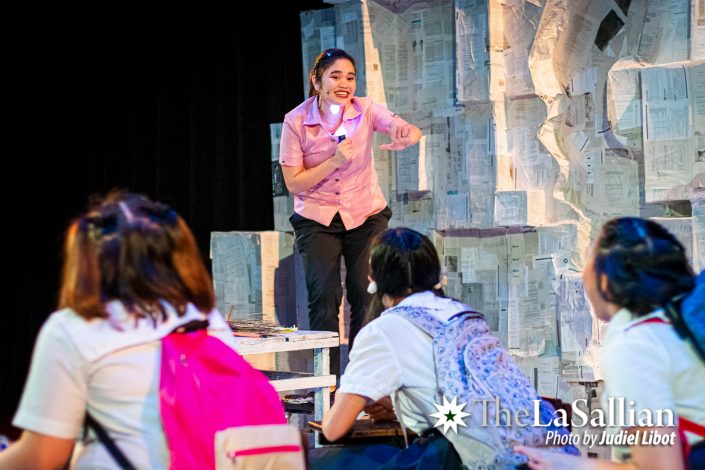[Iba’t iba] naman ang tawag natin sa kanila—tila nagpapakita pa rin sila ng faith, service, at communion in mission,” Project Head Kim Elizabeth De Jesus emphasizes as she addresses the audience of Titser Ko Si La Salle!, a DLSU Harlequin Theatre Guild’s (HTG) production that ran from January 29 to February 1 at the Teresa Yuchengco Auditorium (TYA).
(We may call [our teachers] differently, but they still possess faith, service, and communion in mission.)
This second iteration of Titser Ko Si La Salle! featured a collection of short plays: Ang Projector ni Ma’am, Tser, and Lesson Plan, all written by faculty members from the University’s Literature Department. Epitomizing an emotional love letter to the sacrifice and service of the Filipino teachers, the show successfully expanded the institutional values set by St. John Baptist de La Salle—the patron saint of teachers—300 years after his death.
A field of butterflies
In a setup known as “blackbox theater”, the audience’s space becomes part of the stage in TYA as the actors perform in their midst. Any movement, prop, and lighting is seen and felt up close by the audience as if they were actually living inside each scenario. This creates a much more interactive and immersive experience—allowing the audience to see as the characters see and feel as they feel, becoming privy to the sentiment of returning to the days of one’s youth.
“‘Yun ‘yung plano ko as a director. Kasi para maka-decide ka ng theater space na gagamitin mo, nakadepende yan sa anong klaseng materials ‘yung gagawin mo,” comments HTG Director Raffy Tejada on this stylistic choice. Each story is situated in different classroom settings found in the Philippines.

(That was my plan as a director. Deciding on the theater space to be used in a production would depend on the nature of the material you’re working on.)
This is especially apparent in the first play, Ang Projector ni Ma’am, written by Dr. Genevieve Asenjo. The story explores the struggle of Teacher Tina, a city teacher who has fallen in love with teaching students in the province. Played by Bea Cruz, Tina is shown to be a bit different from her colleagues; in contrast to co-teacher Joy who only works for the monetary compensation, Tina is the embodiment of a strong mother figure, willing to do everything she can to bring her “children” to the height of their successes. This is evident in her buying expensive gadgets for the sake of the class’ needs and incorporating play into their lessons—as the children all sing “Makulay ang buhay sa classroom ni Ma’am.”
(Life is colorful inside Ma’am’s classroom.)
The fun, child-like atmosphere filling her classroom is encased within the promise of Tina’s glorious projector. For instance, aided by lighting that shifts to bright green, the class visualizes the wonders of city life from airplanes to escalators. But amid the innocent dialogue and playful performances in the classroom is the somber reality of Tina’s financial situation at home. The projector then morphs into a symbol beyond its use in the classroom, coming to represent Tina’s legacy—something for the children and audience alike to grasp and reflect on, even long after the play’s conclusion.
Practicality over priority
In Maynard Manansala’s heartbreaking Tser, depicting the grim realities of Lumad schools, the lightest of hues imply the greatest of impacts. Set in Mindanao, the story follows Teacher Rose as she masks her past with a smile, all for the sake of teaching her Lumad students—10th graders yet who are already in their 20s—whose education has long been overdue.
Sophie Saputil’s portrayal of Rose, the wistful math teacher facing a new set of students, does her role justice through tearful confessions and sincere conversations with the students. Mirroring the real events and challenges reportedly faced by Lumad schools at present, Rose delivers an emotional monologue detailing her tragic experience mentoring her students, all too conscious of what their fate will be. “Kapag may natutunan sila sakin, may matutunan rin ako sa kanila,” is one of Rose’s most striking lines, signalling the commitment to educate—a ray of positivity—against the backdrop of her students’ grim realities.

(When [the students] learn from me, I’ll learn something from them.)
Unlike the previous play’s usage of a bright green shade, the flashbacks of war and trauma are cloaked by a harsh red hue. The innocence and joy of the Lumad students on their first day of classes were soon trumped by the violence pervading their surroundings.
A striking theme throughout this tearjerker is the questionable privilege of peace—seen even in the eye-catching attire worn by the performers. The costumes created a subtle color code using the shades of the Philippine national flag, alluding to the rampant violence and lack of peace in the country. Rose wears a simple blue polo shirt, a stand-in for societal justice. The children’s clothing symbolizes aspects of Philippine society that have been lost: white for peace, red for valor, and yellow for unity among the three regions of the Philippines, shadowed by violence in one student’s dark brown shirt. These allow the audience to ponder the unforgiving situations that these people are forced to live through each day .
Supply and demand
Scriptwriter Genaro Gojo-Cruz superbly utilizes flashbacks to bring to life the scenes of Lesson Plan, weaving together the story of Rebecca and her forbidden, one-sided relationship with her student.
Rebecca was brilliantly represented both in her youth and at the brink of her life, portrayed by HTG members Kay Tolentino and Joanna de Leon, and Khai Cruzada, respectively. Her scarf plays a vital role in distinguishing her aged self from her young persona. Lilia, Rebecca’s caretaker who helps in retelling the story, acts as the young Rebecca but merely wearing her scarf—alternating between the past and the present with the simple use of clothing.
The audience is enraptured by both heart-fluttering to heartbreaking moments. The entrance of Julius, portrayed by Bryle Dayacap, and his on-going escapades for Rebecca concocts a romantic comedy, whereas Rebecca’s encounters with sacrifice and loss are equally powerful sentiments weighing in on the narrative.
Ultimately, the impact of the play lies in its time—Rebecca’s reflective narration offers insights gleaned and wisened only in retrospect.

Testament to the teachers
“We really [intended] to show this…last November. Pero ang payo samin ng Office of the Vice President for LaSallian Mission, better to do it sa January in connection with Lasallian Mentors Week,” says Tejeda. He also shares that HTG worked with NSTP and Formation Office Director Carl Fernandez to accurately portray the reality of the Filipino teachers, while also incorporating Lasallian values in the performance.
After the three plays, the cast returned to the stage to explain the social realities that drove the fictional narratives. Be it facing financial crises, war, or ethical dilemmas, teachers are often ready to sacrifice themselves to carve a path for their students.
Up until the curtain call, the audience remained an integral part of the production, invited to sing an ode of thanks to St. La Salle for his unwavering dedication to education. Basked in the glow of light bulbs descending from the ceiling is the portrait of the Patron Saint of Teachers.
As one, the audience and cast recognize the struggle for access to quality education—forming a sense of Lasallian community within the theater. In celebration of the Lasallians Mentors Week and the tercentenary death anniversary of St. La Salle, Titser Ko Si La Salle! brings to the forefront the passion and struggle fueling every great teacher.
Correction: February 5, 2020, 11:30 pm
The article was updated to improve word choices for quote translations. The word “fun” was used instead of “colorful” to translate the expression “makulay”, while “if” was used instead of “when” to translate “kapag”.
In addition, the word “tile” was corrected to “tila”. The publication apologizes for the oversight.
